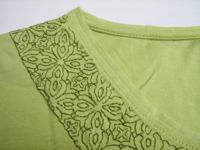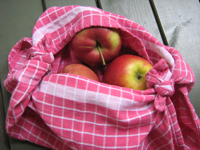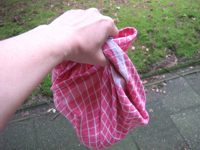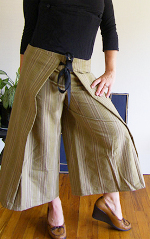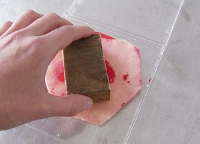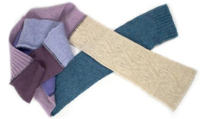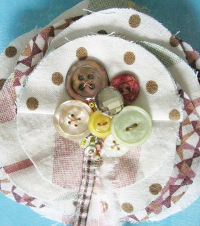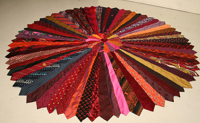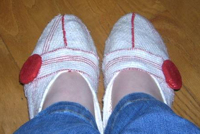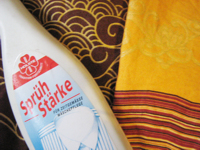 (click to enlarge)
(click to enlarge)
Recently something took me and I thought that you can use those two-coloured charts which are usually associated with filet crochet or cross stitch for a loooot of other techniques, too.
I had this idea already before, in my entries about intarsia knitting, the cross stitch heart, the beaded square stitch heart and the polymer clay letter cane.
On the photo you see some letters worked in different techniques (I’m working on letter charts at the moment ;-)):
'u' - Knit-Purl Knitting, each X is a purl stitch
'n' - Fair Isle Knitting, each X is a white stitch
'i' - Sequins Embroidery, each X is a sequin
'k' - Tapestry Crochet, each X is a white stitch
'a' - Filet Crochet, each X is a filled filet crochet square
't' - Cross Stitch Embroidery on paper, each X is a black cross stitch
'i' - Loom Beading, each X is a black bead
's' - Stamping with square stamps, each X is a black square stamp
's' - Illusion Knitting, each X is a black stitch over two rows
'i' - Crochet Yoyo’s, each X is a white crochet circle from dc’s
'm' - Inverted Filet Crochet, each X is a empty filet crochet square
'a' - Macramée/Friendship Bracelet, each X is a white knot
But then I came up with more techniques and if you still have more ideas I’d be glad if you wrote a comment about.
I added for every technique what would be a square of the chart.
Please remember: Not all ‘units’ are square so that the result can look quite different from the chart!
Knitting
Crochet
- Tapestry Crochet – 1 stitch
- Filet Crochet – 1 filet square (cross = filled square)
- Inverted Filet Crochet – 1 filet square (cross = empty square)
- Crochet Yoyo’s – 1 Crochet Yoyo, viz. a crochet circle from dc’s
Beading
Embroidery
Knotting
Weaving
Sewing
- Patchwork/Quilting – e.g. 1 patchwork square
- Yoyo’s – 1 Yoyo
- Fabric Origami – 1 fabric origami square
Other
By the way I found an blog entry of an embroiderer who thought about the same subject and has more ideas.
Links:
 Double Knitting
Double Knitting
 Picture for sequin embroidery (scroll down to about the middle)
Picture for sequin embroidery (scroll down to about the middle)
 Description of French Knot
Description of French Knot
 Heather’s Friendship Bracelets – Alphabet Patterns
Heather’s Friendship Bracelets – Alphabet Patterns
 Geometric stitching
Geometric stitching
 Google image search result for ‘yoyo blanket’
Google image search result for ‘yoyo blanket’
 Google image search result for ‘ministeck’
Google image search result for ‘ministeck’
Here at unikatissima:
 Celtic Cross Stitch Generator
Celtic Cross Stitch Generator
 Heart Template (at Beaded Square Stitch Heart)
Heart Template (at Beaded Square Stitch Heart)
 Patchwork Knitting
Patchwork Knitting
 Bead Knitting
Bead Knitting
 Illusion knit
Illusion knit
 Tapestry Crochet
Tapestry Crochet
 Beautiful Filet Crochet Patterns
Beautiful Filet Crochet Patterns
 Loom Woven Bead Bracelet
Loom Woven Bead Bracelet
 Beaded Square Stitch Heart
Beaded Square Stitch Heart
 Bead Knitting
Bead Knitting
 Freeform Bead Embroidery
Freeform Bead Embroidery
 Bead embroidered Paisleys
Bead embroidered Paisleys
 Friendship Bracelet
Friendship Bracelet
 Crazy Daisies
Crazy Daisies
 Crazy Daisies II
Crazy Daisies II
 Tablet or Card Weaving
Tablet or Card Weaving
 YoYo Pin
YoYo Pin
 Fabric Origami
Fabric Origami
 Mosaic Table Light (Glass Paint)
Mosaic Table Light (Glass Paint)
 Polymer Clay Letter Cane
Polymer Clay Letter Cane
 Mosaic from Plaster
Mosaic from Plaster
 Eraser Stamps
Eraser Stamps
